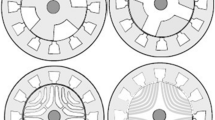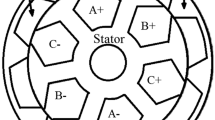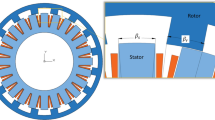Abstract
The purpose of this paper is to propose a new external rotor switched reluctance motor as a suitable prototype to produce high torque per volume with minimum leakage flux in small size applications. To evaluate the proposed configuration, its structure is introduced firstly, and the main characteristics such as flux density, flux linkage, self-inductance, mutual inductance, and output torque are analyzed numerically via three-dimensional finite element method. Subsequently, the obtained results are compared with those of a conventional motor; furthermore, the obtained results are validated in a laboratory set-up. The experimental and numerical analysis shows that this motor structure can help users to produce higher output torque per volume, with minimum leakage flux.












Similar content being viewed by others
References
Grbo Z, Vukosavic S (2006) Cost-optimized switched reluctance motor drive with bipolar currents. Electr Eng 89(3):183–191
Lee C, Krishnan R, Lobo NS (2009) Novel two-phase switched reluctance machine using common-pole E-core structure: concept, analysis, and experimental verification. IEEE Trans Ind Appl 45(2):703–711
Chen HJ, Jiang DQ, Yang J, Shi LX (2009) A New Analytical Model for Switched Reluctance Motors. IEEE Trans Magn 45(8):3107–3113
Tomczewski K, Wach P (2003) Control characteristics for quasi-optimal operation of switched reluctance motors. Electr Eng 85(5):275–281
Ding W, Liang D, Sui H (2010) Dynamic modeling and performance prediction for dual-channel switched reluctance machine considering mutual coupling. IEEE Trans Magn 46(9):3652–3663
Li J, Song X, Cho Y (2008) Comparison of 12/8 and 6/4 switched reluctance motor: noise and vibration aspects. IEEE Trans Magn 44(11):4131–4134
Ding W, Liang D (2008) Modeling of a 6/4 switched reluctance motor using adaptive neural fuzzy inference system. IEEE Trans Magn 44(7):1796–1804
Daldaban F, Ustkoyuncu N (2007) New disc type switched reluctance motor for high torque density. Energy Convers Manage 48(8):2424–2431
Toulabi MS, Torkaman H, Afjei E (2012) Experimental and numerical comparison between the output voltages of two novel switched reluctance generators. COMPEL: Int J Comput Math Electr Electron Eng 31(2):401–423
Park JH, Jang SM, Choi JY, Sung HK, Kim I (2010) Dynamic and experimental performance of linear-switched reluctance machine with inductance variation according to airgap length. IEEE Trans Magn 46(6):2334–2337
Torkaman H, Afjei E (2013) Comprehensive detection of eccentricity fault in switched reluctance machines using high frequency pulse injection. IEEE Trans Power Electron 28(3):1382–1390
Torkaman H, Afjei E, Yadegari P (2012) Static, dynamic, and mixed eccentricity faults diagnosis in switched reluctance motors using transient finite element method and experiments. IEEE Trans Magn 48(8):2254–2264
Hennen MD, De Doncker RW (2007) Comparison of outer- and inner-rotor switched reluctance machines. In: Paper presented at the 7th International Conference on Power Electronics and Drive Systems, Thailand, 27–30 Nov
Jiongkang L et al (2009) Experimental investigation of in-wheel switched reluctance motor driving system for future electric vehicles. In: Paper presented at the 3rd International Conference on Power Electronics Systems and Applications, PESA, Hong Kong, 20–22 May
Desai PC, Krishnamurthy M, Schofield N, Emadi A (2010) Novel switched reluctance machine configuration with higher number of rotor poles than stator poles: concept to implementation. IEEE Trans Ind Electron 57(2):649–659
Kowol M, Łukaniszyn M, Latawiec KJ (2010) Modeling and construction optimization of a modular TFM with an outer rotor. Electr Eng 92(3):111–118
Wrobel R, Mellor PH, McNeill N, Staton DA (2010) Thermal performance of an open-slot modular-wound machine with external rotor. IEEE Trans Energy Convers 25(2):403–411
Chen J, Nayar CV, Xu L (2000) Design and finite-element analysis of an outer-rotor permanent-magnet generator for directly coupled wind turbines. IEEE Trans Magn 36(5):3802–3809
Schmidt E, Eilenberger A (2009) Calculation of position-dependent inductances of a permanent magnet synchronous machine with an external rotor by using voltage-driven finite element analyses. IEEE Trans Magn 45(3):1788–1791
More DS et al (2008) Outer rotor flux reversal machine for rooftop wind generator. In: Paper presented at the IEEE Industry Applications Society Annual Meeting, Canada, 5–9 Oct
Boughrara K, Ibtiouen R, Zarko D, Touhami O, Rezzoug A (2010) Magnetic field analysis of external rotor permanent-magnet synchronous motors using conformal mapping. IEEE Trans Magn 46(9):3684–3693
Linni J, Chau KT, Jiang JZ (2009) A magnetic-geared outer-rotor permanent-magnet brushless machine for wind power generation. IEEE Trans Ind Appl 45(3):954–962
Holik PJ, Dorrell DG, Popescu M (2007) Performance improvement of an external-rotor split-phase induction motor for low-cost drive applications using external rotor can. IEEE Trans Magn 43(6):2549–2551
Afjei E, Torkaman H (2009) The novel two phase field-assisted hybrid SRG: magnetio static field analysis, simulation, and experimental confirmation. Prog Electromagn Res B PIER 18:25–42
Afjei E, Torkaman H (2011) Finite element analysis of SRG under fault condition oriented towards diagnosis of eccentricity fault. Appl Comput Electromagn Soc 26(1):8–16
Torkaman H, Afjei E (2012) Comparison of three novel types of two-phase switched reluctance motors using finite element method. Progress in Electromagnetics Research, PIER 125:151–164
Torkaman H, Afjei E, Toulabi MS (2012) New double-layer-per-phase isolated switched reluctance motor: concept, numerical analysis, and experimental confirmation. IEEE Trans Ind Electron 59(2):830–838
Afjei E, Torkaman H (2010) Comparison of two types of dual layer generator in field assisted mode utilizing 3D-FEM and experimental verification. Prog Electromagn Res B PIER 23:293–309
Anwar MN, Husain I, Radun A (2001) A comprehensive design methodology for switched reluctance machines. IEEE Trans Ind Appl 36(6):1684–1692
Magnet CAD package (2007) User manual. Infolytica Corporation Ltd., Montreal. First published.
Torkaman H, Afjei E (2011) Magnetostatic field analysis and diagnosis of mixed eccentricity fault in switched reluctance motor. Electromagnetics 31(5):368–383
Acknowledgments
This work was supported by vice-presidency of research and technology of Shahid Beheshti University.
Author information
Authors and Affiliations
Corresponding author
Rights and permissions
About this article
Cite this article
Torkaman, H., Afjei, E., Gorgani, A. et al. External rotor SRM with high torque per volume: design, analysis, and experiments. Electr Eng 95, 393–401 (2013). https://doi.org/10.1007/s00202-012-0265-3
Received:
Accepted:
Published:
Issue Date:
DOI: https://doi.org/10.1007/s00202-012-0265-3




